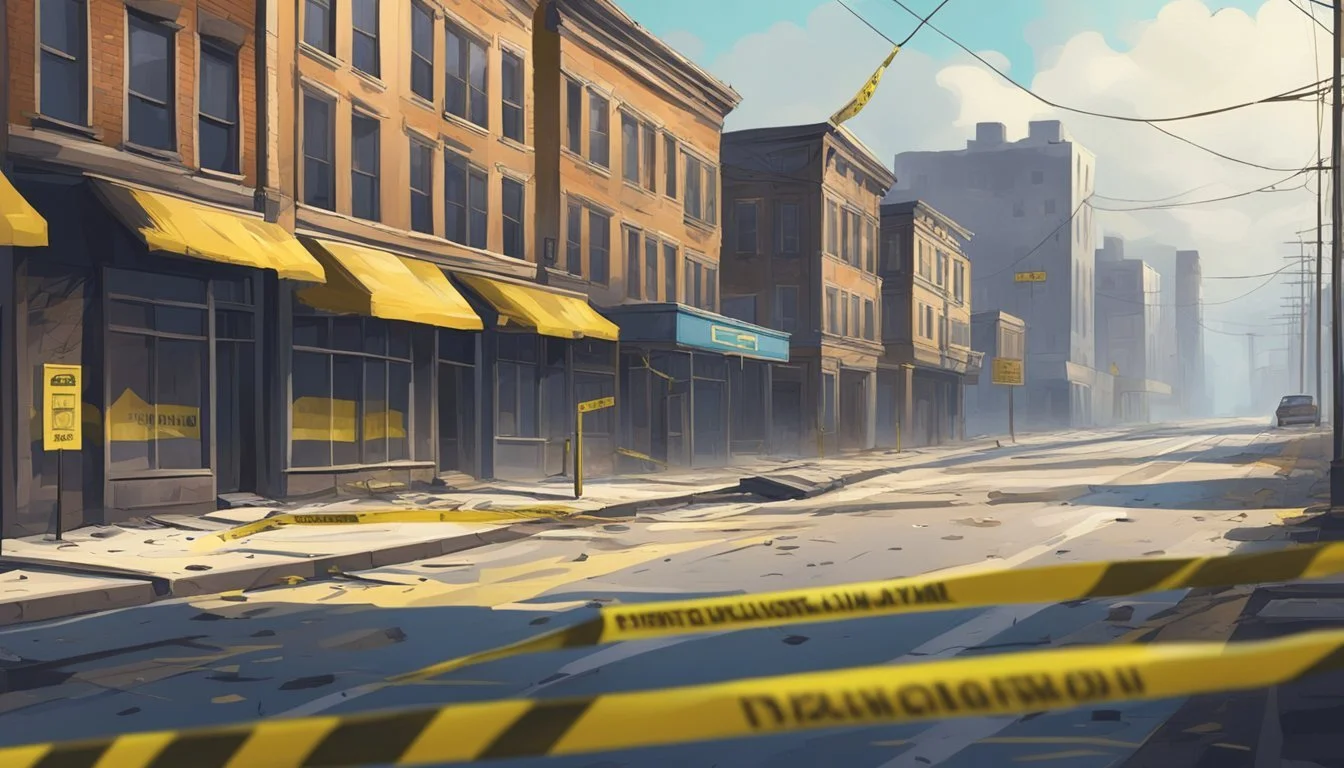Silent Streets: Chester Turner's South Central Killing Fields
Unmasking LA's Deadliest Serial Killer
Chester Turner's reign of terror in South Los Angeles during the late 1980s and early 1990s left an indelible mark on the community. The serial killer targeted vulnerable women in neighborhoods like Chesterfield Square, transforming quiet streets into hunting grounds. Turner's crimes claimed the lives of at least 14 women, making him one of the most prolific serial killers in Los Angeles history.
The areas around Western Avenue and Slauson Avenue became epicenters of fear as Turner's victims were discovered. His actions devastated families and shook the South Central community to its core. The case highlighted systemic issues in law enforcement and society's treatment of marginalized populations.
Turner's eventual capture and conviction in 2007 brought some closure to the victims' families. However, the scars left on South Los Angeles remain, serving as a somber reminder of a dark chapter in the city's history. The case continues to impact discussions about crime, justice, and community healing in Los Angeles.
Profile of a Serial Killer
Chester DeWayne Turner's reign of terror in South Central Los Angeles revealed a ruthless predator with a disturbing pattern of violence. His early life and psychological makeup offer insights into the development of a serial killer.
Chester DeWayne Turner: The Early Years
Born on November 5, 1966, Chester Turner grew up in a turbulent environment in South Los Angeles. His childhood was marked by instability and poverty. Turner struggled academically and dropped out of high school.
As a young adult, Turner drifted between temporary jobs and homelessness. He began accumulating a criminal record for theft and other minor offenses. These early brushes with the law foreshadowed his future descent into more serious crimes.
Turner's unstable lifestyle and lack of permanent address made him difficult to track, allowing him to evade detection for years.
Psychological Profile and Modus Operandi
Turner exhibited traits common to many serial killers, including a lack of empathy and a propensity for violence. He targeted vulnerable women, often those involved in sex work or struggling with addiction.
His method of murder was consistent:
Lured victims to secluded areas
Sexually assaulted them
Strangled them to death
Turner's crimes showed a pattern of escalating violence and frequency over time. He seemed to derive a sense of power and control from his attacks.
DNA evidence ultimately linked Turner to multiple crime scenes, revealing the full extent of his killing spree. His actions demonstrated a complete disregard for human life and a compulsion to continue his brutal attacks.
Timeline of Terror
Chester Turner's reign of terror in South Los Angeles spanned over a decade, leaving a trail of victims and devastated communities in its wake. His murders exposed systemic issues and shook the foundations of community trust.
The Unraveling of South Central's Nightmare
In the late 1980s, South Los Angeles faced a growing crisis as women began disappearing from the streets. The first known victim of Chester Turner was found in 1987. Over the next 11 years, Turner targeted vulnerable individuals, primarily homeless women and sex workers.
His crimes often went unnoticed or uninvestigated due to the victims' marginalized status. This period saw a surge in crack cocaine use and street prostitution, creating an environment where Turner could operate with relative impunity.
Key Murders and Convictions
Turner's victims were typically found strangled in abandoned buildings or alleys across South Los Angeles and Downtown. Notable cases include:
1987: Diane Johnson, 21, found murdered in South Los Angeles
1989: Annette Ernest, 26, discovered in an abandoned building
1993: Desarae Jones, 29, killed while pregnant
Turner was ultimately convicted of 14 murders, including that of a viable fetus. His method of killing was consistent - sexual assault followed by strangulation. DNA evidence played a crucial role in linking Turner to these crimes years later.
Capture and Arrest
Chester Turner's capture came in 2002 when he was arrested for a sexual assault unrelated to the murders. Routine DNA testing linked him to the unsolved homicides. This breakthrough led to a wider investigation and the discovery of more victims.
Turner was formally charged with multiple murders in 2004. His trial began in 2007, revealing the full extent of his crimes to a shocked public. The proceedings highlighted the importance of DNA analysis in solving cold cases.
In 2007, Turner was convicted of 10 murders and sentenced to death. He remains on death row at San Quentin State Prison. The case prompted renewed focus on community vigilance and improved investigative practices for crimes against marginalized populations.
Investigation and Evidence
The investigation into Chester Turner's crimes relied heavily on DNA evidence and meticulous police work. Advanced forensic techniques and database matching played crucial roles in linking Turner to multiple murders across South Central Los Angeles.
Role of DNA Evidence in the Case
DNA evidence proved instrumental in solving the Chester Turner case. The LAPD crime lab analyzed DNA samples collected from victims' bodies and crime scenes. These samples were run through CODIS, the national DNA database, leading to matches with Turner's profile. In 2002, a DNA sample taken from Turner after an unrelated arrest linked him to several unsolved murders. This breakthrough allowed investigators to connect him to numerous cold cases dating back to the 1980s and 1990s.
The DNA evidence was particularly crucial in cases involving sex workers and victims from Skid Row, where traditional investigative methods often faced challenges. It provided irrefutable proof of Turner's involvement in multiple homicides across South Central Los Angeles.
LAPD's Involvement and Techniques
The Los Angeles Police Department employed various techniques to investigate the string of murders. Detectives meticulously combed through cold case files, looking for patterns and similarities. They reexamined physical evidence from crime scenes and conducted new interviews with witnesses and survivors.
LAPD's cold case unit played a vital role in piecing together the puzzle. They used advanced computer software to analyze crime patterns and victim profiles. This helped them identify potential links between seemingly unrelated cases.
Undercover operations were also conducted in areas frequented by sex workers, aimed at gathering information and preventing further crimes. The LAPD collaborated with other law enforcement agencies to share data and resources, enhancing their ability to track and apprehend Turner.
The Victims
Chester Turner's crimes left a trail of devastation across South Central Los Angeles. His victims were predominantly African American women, many of whom were vulnerable due to difficult life circumstances. The impact of these murders rippled through families and communities, leaving scars that persist to this day.
Remembering the Lives Lost
Turner was convicted of murdering 14 women between 1987 and 1998. Most victims were found along Figueroa Street south of the 10 Freeway. Many were sex workers or struggled with addiction. One victim was pregnant, leading to an additional charge for the death of her unborn child.
The victims ranged in age from 21 to 45. They included:
Diane Johnson, 21
Annette Ernest, 26
Anita Fishman, 31
Regina Washington, 27 (pregnant)
Each woman had a unique story and loved ones who mourned their loss. Their deaths highlighted the vulnerability of marginalized women in the community.
Impact on Families and Communities
The murders devastated victims' families and shook South Central LA neighborhoods. Many families struggled with grief, anger, and a sense of injustice. Some victims' children grew up without mothers. Communities grappled with fear and distrust.
The crimes exposed systemic issues:
Lack of protection for vulnerable women
Slow police response in minority neighborhoods
Need for addiction and mental health support
Some families formed support groups to cope with their loss. Community organizations worked to improve safety and support for at-risk women. The case sparked discussions about protecting marginalized individuals and addressing root causes of violence.
Legal Proceedings and Outcomes
Chester Turner faced justice for his heinous crimes in Los Angeles. His trial, sentencing, and subsequent time on death row marked significant milestones in the case.
Trial and Sentencing
Chester Turner's trial began in 2007. Prosecutors presented DNA evidence linking him to multiple murders. The jury found Turner guilty of 10 counts of first-degree murder and one count of second-degree murder for the death of an unborn child.
During the penalty phase, victims' families provided emotional testimony. The jury recommended the death penalty. On July 10, 2007, the judge sentenced Turner to death for his crimes.
Death Row and Appeals
Turner was transferred to San Quentin State Prison's death row after sentencing. He joined over 700 other inmates awaiting execution in California. Turner's lawyers filed appeals, a standard process for death row inmates.
In 2014, Turner faced additional charges. Prosecutors linked him to four more murders through DNA evidence. He was convicted of these crimes in 2014, receiving four more death sentences. Turner remains on death row as his appeals continue through the legal system.
Wrongful Conviction and Exoneration
Chester Turner's crimes led to a grave miscarriage of justice. An innocent man spent years behind bars before DNA evidence revealed the truth and set him free.
The Case of David Allen Jones
David Allen Jones, a mentally disabled man, was wrongfully convicted of three murders in South Central Los Angeles in 1992. He spent nearly a decade in prison for crimes he did not commit. Jones' case highlights the flaws in the justice system that can lead to wrongful convictions.
Prosecutors relied heavily on a confession Jones made under intense questioning. His intellectual disabilities made him particularly vulnerable to coercion and false confessions. The police failed to thoroughly investigate other suspects or pursue alternative leads.
In 2004, DNA evidence linked Chester Turner to the murders for which Jones had been convicted. This scientific breakthrough exonerated Jones and exposed the true killer.
Restoring Justice
Jones' exoneration in 2004 marked a turning point in the case. He was released from prison and awarded $720,000 in compensation for his wrongful imprisonment. The Los Angeles Police Department faced scrutiny for their handling of the investigation.
The case prompted reforms in interrogation techniques and increased safeguards for vulnerable suspects. It also highlighted the importance of DNA evidence in solving cold cases and preventing wrongful convictions.
Jones' exoneration allowed investigators to reopen unsolved murders in the area. This led to the discovery of Turner's extensive killing spree and brought closure to many victims' families.
Societal Implications
Chester Turner's crimes exposed deep-rooted issues in South Central Los Angeles. His targeting of vulnerable individuals highlighted systemic problems faced by marginalized communities.
Homelessness and Vulnerability
Homelessness placed many of Turner's victims at heightened risk. Lack of stable housing left them exposed to danger on the streets. Many homeless women struggled to access safe shelters or support services.
Turner exploited this vulnerability, preying on those society often overlooked. His ability to operate undetected for years revealed gaps in protection for homeless individuals.
Limited resources for homeless outreach and support contributed to the problem. Overwhelmed shelters and insufficient mental health services left many without refuge.
Poverty, Drug Abuse, and Crime in South Central
South Central Los Angeles grappled with interconnected issues of poverty, drug abuse, and crime. Economic hardship pushed some residents toward illegal activities to survive.
The crack cocaine epidemic ravaged communities, fueling addiction and violence. Drug-related crime spiked, straining law enforcement resources.
Poverty limited access to education and job opportunities. This created a cycle of desperation for many residents. Some turned to sex work or other high-risk behaviors to make ends meet.
Turner's crimes occurred against this backdrop of social decay. The area's challenges allowed him to blend in and avoid detection.
Public Perception and Media Influence
Media coverage of Turner's crimes shaped public perception of South Central. Some reports sensationalized the violence, reinforcing negative stereotypes about the area.
Others highlighted systemic issues that enabled Turner's killing spree. This sparked discussions about racial and economic disparities in law enforcement priorities.
The case drew attention to the "less dead" phenomenon. This refers to crimes against marginalized groups receiving less media coverage and police attention.
Public pressure eventually led to increased focus on unsolved murders in the area. This shift helped bring Turner and other serial killers to justice.
Comparative Analysis with Other Serial Killers
Chester Turner's crimes bear striking similarities to other notorious serial killers, yet his case stands out in terms of scale and impact on South Central Los Angeles.
Similarities in Modus Operandi
Chester Turner's methods shared common traits with other prolific serial killers. Like the Night Stalker Richard Ramirez, Turner targeted vulnerable victims in urban areas. Both killers struck at night, using the cover of darkness to their advantage.
Turner's pattern of strangulation mirrored that of many serial murderers, including the Southside Slayer. This method allowed for a quiet, controlled kill that minimized evidence left behind.
The use of public spaces as dumping grounds for bodies was another shared trait. Turner, like other serial killers, often left his victims in alleys or vacant lots, complicating investigations.
Prolific Killers: A Side-By-Side Look
Chester Turner's victim count places him among the most prolific serial killers in Los Angeles history. With 13 confirmed victims, his toll surpasses that of Richard Ramirez, who had 13 murder convictions.
Serial Killer Confirmed Victims Years Active Chester Turner 13 1987-1998 Richard Ramirez 13 1984-1985 Lonnie Franklin Jr. 10 1985-2007
Turner's long period of activity, spanning over a decade, is notable. This extended timeframe allowed him to amass a high victim count, similar to other prolific American serial killers.
The geographic concentration of Turner's crimes in South Central Los Angeles set him apart from killers like Ramirez, who ranged more widely across Southern California.
Preventative Measures and Law Enforcement
Law enforcement agencies implemented new strategies and technologies to combat serial killers like Chester Turner. Community involvement also played a crucial role in enhancing public safety and preventing future crimes.
Improving Investigations and Technology
The LAPD established a dedicated cold-case unit to reexamine unsolved murders. This team utilized advanced DNA testing techniques and the CODIS database to link evidence from multiple crime scenes.
Improved forensic methods allowed investigators to extract DNA from smaller samples, increasing the chances of identifying perpetrators. The department also invested in better data management systems to track patterns across cases.
Training programs were developed to help detectives recognize potential serial killer activity earlier. This included studying common behavioral patterns and crime scene signatures.
Community Role in Safety and Prevention
Neighborhood watch programs expanded in South Central LA, encouraging residents to report suspicious activities. Community leaders worked with law enforcement to improve lighting in high-risk areas and organize self-defense classes.
Local shelters implemented stricter security measures to protect homeless individuals, a group often targeted by Turner. Some facilities installed surveillance cameras and hired security guards.
Public awareness campaigns educated residents about personal safety practices. These efforts focused on reducing vulnerability, especially among sex workers and other at-risk populations.
Community centers offered support services and resources to help individuals escape dangerous situations. This included job training programs and addiction counseling to address underlying issues.









